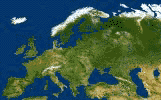 |
 |
 |
||||||||
An overview
You are on the page "Introduction"
Source :

A clear picture of the state of the environment in Europe and the main areas requiring action at national or international level are presented in the report, Europe’s Environment: The Second Assessment, summarised in this overview. Designed to form a key input to the June 1998 Environment for Europe Conference in Aarhus, the fourth meeting of Environment Ministers of all European countries, the report builds on and updates Europe’s Environment: The Dobris Assessment, the first pan-European state of the environment report published in 1995 by the European Environment Agency (EEA). That comprehensive report covered 46 countries and, based largely on data up to around 1992, provided an assessment of the state of the environment throughout Europe at that time. The Dobris assessment was presented to the third conference of Environment Ministers of all European countries, which met in Sofia in October 1995. These conferences aim to set out principles and policies for improving the environment, moving towards convergence of environmental policies in the pan-European region, and achieving a more sustainable pattern of development in Europe. At the Sofia meeting, the Ministers welcomed the report as an important baseline document against which future progress under the Environmental Programme for Europe (EPE) could be assessed. They asked the EEA to produce a second assessment in time for their next planned meeting in Denmark in 1998. Europe’s Environment: The Second Assessment is the Agency’s response to this request. The report concentrates on the 12 key environmental problems focused upon in the earlier report and shows how the situation has developed since the start of the Environment for Europe process in 1991 (in practice 1990 is often taken as the reference year). This focus, based on the mandate from the Sofia ministerial conference, means that not all environmental problems occurring in Europe are reported on here. Future reports from the European Environment Agency will aim to be gradually more comprehensive. These will be supplemented with particular assessments targeted on specific problems of concern, while gradually extending their geographical coverage. In addition to providing information about the state of the environment and trends in 12 environmental problems, this report identifies the main socio-economic driving forces exerting pressure on the European environment. While presenting a clear picture of the changing state of the environment, the report identifies key areas where further action is needed. Environmental experts from many European countries have helped the EEA to prepare this report. Unfortunately, mechanisms to collect harmonised data on the environment on a European scale are still inadequate, despite the priority given to this in the EPE. The resources made available for preparing this report were not by themselves sufficient to overcome this problem, and coverage of countries thus varies throughout the report. In particular, a bias towards Western Europe could not be avoided. Nevertheless, the report provides the most comprehensive and reliable overview, with conclusions supported by a substantial body of background material from the whole of Europe. The next section of this overview summarises progress with the main European environmental problems and concludes with an analysis of the contribution of the principal societal sectors to the problems and their solutions. The final section provides summaries of the 12 environmental topics reviewed in the main report. Box 1.2: Country groupings used in this report: Western Europe: (EU+EFTA+Switzerland) Austria, Belgium, Denmark, Finland, France, Germany, Greece, Ireland, Italy, Luxembourg, the Netherlands, Portugal, Spain, Sweden, United Kingdom, + Iceland, Liechtenstein, Norway, Switzerland CEE: Central and Eastern Europe (all central European countries, the Baltic States, Turkey, Cyprus and Malta) Albania, Bosnia-Herzegovina, Bulgaria, the Czech Republic, Croatia, Estonia, FR of Yugoslavia, FYROM, Latvia, Lithuania, Hungary, Poland, Romania, Slovak Republic, Slovenia, and Turkey, Cyprus and Malta NIS: the European Newly Independent States (not including the Baltic states) Armenia, Azerbaijan, Belarus, Georgia, Moldova, the Russian Federation, the Ukraine In the text, for convenience, the term Eastern Europe is sometimes used to cover both Central and Eastern European countries and the Newly Independent States. |
|||||||||
